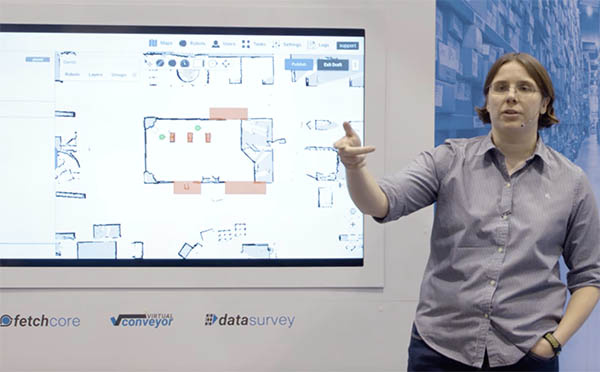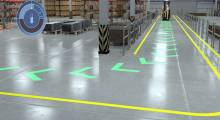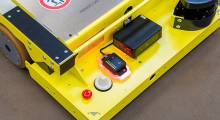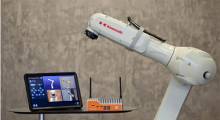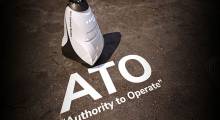World Day for Safety and Health at Work last week provided an opportunity to consider how technology can improve working conditions. In warehouses and factories around the world, people move heavy boxes and carts, repetitively pick items, and operate machinery in narrow spaces.
Industrial mobile robots (IMRs) promise to improve worker safety and reduce physical strain while also increasing throughput and ultimately profits. The challenges of recruitment, retention, and accelerated e-commerce demand have led more operations to adopt automation. However, both developers and users need to be aware of safety requirements and emerging standards.
The American National Standards Institute and the Association for Advancing Automation (formerly the Robotic Industries Association) have issued ANSI/RIA R15.08, a safety standard for the use of autonomous mobile robots (AMRs) in industrial environments. It is based on the R15.06 standard for robotic arms. Compliance can help companies avoid liability, fines, and higher insurance costs, according to Zebra Technologies.
“At MODEX, I saw a lot of vendors whose robots were not truly collaborative,” said Melonee Wise, formerly the CEO of Fetch Robotics and now vice president of robotics automation at Zebra. “Cobot arms are usually stationary, so the scope of risk is contained, but with AMRs, the whole warehouse is the problem.”
R15.08 to help people think ahead
“A lot of people see AMRs as devices that can solve all problems, but they're not like robots in safety cages or on fixed tracks,” Wise said. “The standard is also about educating users and integrators about the fact that all robots have requirements and limitations and how to think about them.”
“In December 2021, we published the first part of the standard, which outlined what manufacturers need to do to make devices conform,” said Wise, who contributed to R15.08. “Can you define what a warehouse is and where robots are supposed to drive? We created a new terminology around 'specified operating environments.' This includes areas like elevators, automatic doors, or 'airlocks' in a fabrication situation.”
“We're trying to help end users and integrators understand the scope of the possible,” she said. “For example, any modification in a warehouse, like adding a ladder or a glass wall in the middle, won't work because of lidar. There simple things people can do, like put tape on the glass in the deployed operating environment. We want to help them think more proactively about safety.”
“AMR providers aren't the ones doing this, but integrators are,” Wise said. “In many deployments, integrators provide the glue between the autonomy and more traditional systems. It's important that they educate themselves and get involved with the standard as soon as possible.”
Standards must assess the state of tech
Previous standards didn't take into account the state of existing technology or the potential for future development, noted Wise.
“One of the things about B56.5, which covered automated guided vehicles or AGVs, was that no lidar on the market could meet the detection specification in that standard,” she said. “We want to make sure the standard is implementable and reasonable.”
Wise said she didn't have statistics for safety incidents involving AMRs, but there have been problems with towing AGVs over the past 10 years.
“Another thing we're seeing is ergonomics in e-commerce,” she said. “Not eveyrone is thinking about the height of a shelf in a picking zone; they're just worried about people getting hit by robots. We considered that with our FlexShelf.”
Among the trends at MODEX 2022 was the rise of taller autonomous lifts. Wise said most of these systems, which are counterbalanced rather than rely on floor stabilizers, are designed with safety in mind. “We're seeing more non-compliance with devices of 300 kg [661.3 lb.] and below,” she said.
Fetch/Zebra goes above and beyond
Before it was acquired by Zebra, Fetch announced last year that its entire AMR fleet follows the new standard.
“Even in the past year, we've implemented behaviors in the navigation stack,” Wise said. “While they can't be held to functionally safe performance levels, they increase the safety of the platform by handling certain scenarios in the warehouse—for example, social navigation behavior, or keeping the robot on the right side of an aisle. We can't safety rate that, but it makes interactions with people more predictable.”
“It's the same with the machine learning stuff we've done with forklift detection,” she added. “It's hard to safety rate but another layer on top of our base security, minimizing scenarios that can cause risk of injury.”
Part 2 in the works
The R15.08 committee is working on Part 2, which will put more defined “guardrails” around partially completed machines like those integrators assemble for workcells, said Wise.
“For the past seven years in the AMR space, it was the Wild West with integrators,” Wise said. “We're also very focused on helping them and end users understand their roles.”
“Six years ago, the committee was 15 people,” she recalled. “Now, 80 to 90 companies and individuals are involved—from manufacturers and sensor providers to end users like Procter & Gamble, General Motors, and Ford. We hope to publish it later this year.”
“We're trying to get alignment with OSHA [the Occupational Safety and Health Administration] to make it a compulsory standard,” Wise said. “Safety is like religion—you either believe in it, or you don't. Larger manufacturers largely get it, but as robots push into logistics and distribution, there isn't the same belief.”
“Over the past couple of years, we've interacted with prospective customers who ask, 'Why can't you do this?' and we'll say, 'Because the safety standard says it isn't a good idea.' They'll come back and say, 'Your competitors do this.' This creates a situation where vendors are pushed to stretch the boundaries of safety to sell their products, which is good for no one.”
About the Author
Follow Robotics 24/7 on Linkedin
Article topics
Email Sign Up

